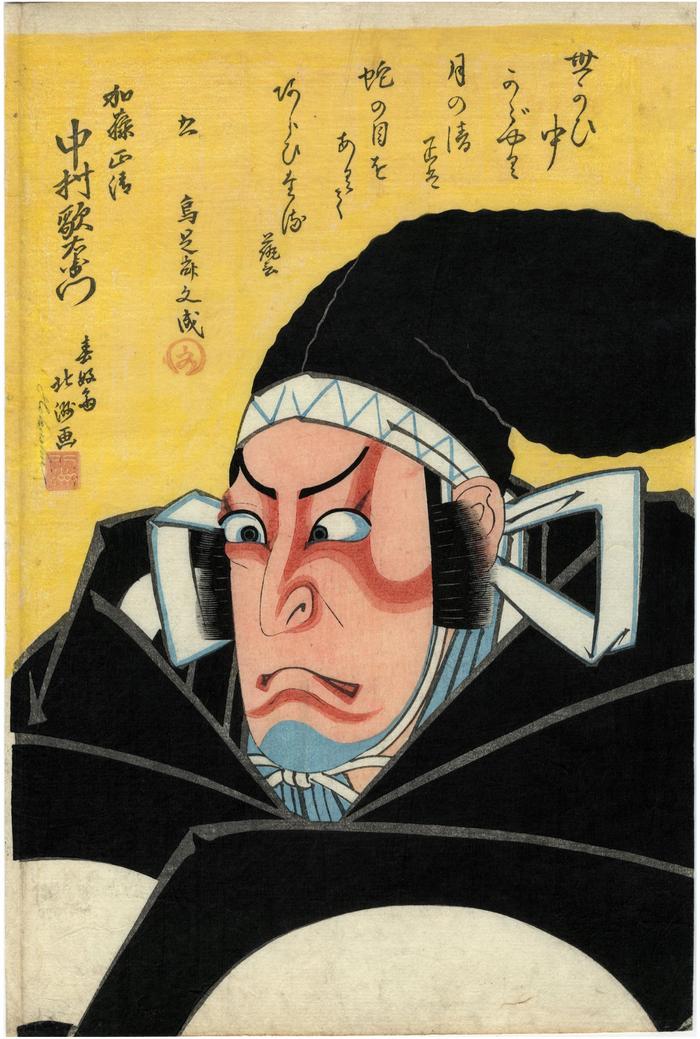Shunkōsai Hokushū (春好斎北洲) (artist ca 1808 – 1832)
Nakamura Utaemon III (中村歌右衛門) as Katō Masakiyo (加藤正清)
09/21/1820
Signed: Shunkōsai Hokushū ga
春好斎北洲画
The National Museum of Asian Art
Museum of Fine Arts, Boston
Library of Congress
British Museum
Philadelphia Museum of Art - with a blue ground and poet's seal
Kabuki21 - summary of the play Hachijin Shugo no Honjō
Hankyu Culture Foundation
Musées royaux d'art et d'histoire - missing the poet's personal seal There are three prints in the Lyon Collection showing Utaemon III as Katō Masakiyo. Each shows him in the same dramatic costume and is said to date from ca. 1820. The other two are another one by Hokushū and one by Yoshikuni.
****
Nakamura Utaemon III (1778-1838) was the most versatile and popular actor in Osaka stage history, with half the color woodcut print production dedicated to images of him in many years. This portrait of the actor depicts a tense moment in the play Hachijin shugo no honjō ('8 Battle-ranks in Defense of Osaka Castle' [八陣守護城]) in which he, as Masakiyo, loosely based on the warlord Katō Kiyomasa (1562-1611), has just knowingly swallowed poisoned saké in order to protect his lord’s heir and Osaka Castle. The poem, by Chōsokusai Fuminari, above the actor’s head references the real, historical figure:
shining on the world
at midday:
an art of piercing insight.
Trans.Roger Keyes, The Theatrical World of Osaka Prints. (Philadelphia: Philadelphia Museum of Art, 1973), 68.
From Ukiyo-e Prints in the Mike Lyon Collection by Cori Sherman North
****
The text reads: 世かひ中かゞやく月の清正は蛇の目をあくてあらひたる芸 右 鳥足斎文成
****
"A symbol of courage and loyalty in the face of lethal treachery, the hero in the play knowingly drinks poisoned sake at a banquet and suffers great pain as he wills himself to live so that he can continue to protect the son of his late master, who represents the historical hegemon Toyotomi Hideyoshi, from the ruthlessly ambitious character representing Tokugawa Ieyasu, the first shogun of the Tokugawa shogunate.
Here Utaemon III wears the formal robe emblazoned with large disks that is customary for the character Masakiyo in the banquet scene... This portrait focuses on his head and shoulders, vividly capturing his exaggerated stare and the details of his stage makeup (kumadori). Above the actor's head is inscribed a poem, with the poet's name, Chōsokusai Fuminari....
This print [that is the one in the van Biema collection] is based on a performance of Hachijin shugo no honjō at the Kado Theater in Osaka in the ninth month of 1820. Roger Keyes has argued for a later date of publication, in the spring of 1822, as part of a series of bust portraits on yellow backgrounds by the artist Hokushū. Another state of this print, which Keyes regards as earlier, has a blue background and the name of the actor and his role printed in the space in the upper left."
[The choice of bold type was ours. While the print in the Lyon Collection shows the name of the actor in the upper left and the van Biema one does not, the Lyon Collection print shown here has a yellow ground and not a blue one. Curious.]
Quoted from: Masterful Illusions: Japanese Prints in the Anne van Biema Collection, p. 144.
****
"Some impressions have a zigzag pattern on the white ribbon of the head-gear, instead of the pattern of semi-hexagons shown in the print illustrated here. The impressions with the pattern of semi-hexagons are probably the earlier ones, since a print by the artist Yoshikuni depicts Utaemon full-length in the same role in the performance 9/1820, also wearing this head-gear with the white ribbon and semi-hexagons.
The seals of the poet and the artist are not present on later impressions, while the publisher's trademark 'Den' (Izutsuya Dembei) is added.
There is also registered an impression without the mentioning of the actor's name and role." Quoted from: Ōsaka Kagami 大阪鏡 by Jan van Doesburg, page 35.
****
Illustrated:
1) in a black and white reproduction in the Illustrated Catalogues of Tokyo National Museum: Ukiyo-e Prints (3), #3925.
2) in color in Kabuki Heroes on the Osaka Stage 1780-1830 by C.Andrew Gerstle with Timothy Clark and Akiko Yano, #187, p. 207. "A striking portrait of Shikan II in the role of the Osaka hero Katō Masakiyo, crossing his eyes and grimacing for a dramatic 'stage post' (mie). Masakiyo was the fictional name given by convention to warlord Katō Kiyomasa (1562-1611), who defied Tokugawa Ieyasu of Edo (known as Kitabake in the play). Masakiyo sacrifices himself by drinking poison in an effort to save the heir of his lord Toyotomi Hideyoshi and Osaka Castle from the treacherous Ieyasu, who had earlier pledged to protect the Toyotomi clan.
The kyōka poem inscribed above reads:
Sekaijū/ kagayaku tsuki no/ Kiyomasa wa/ janome o akete/ araitaru gei....Shikan is the star whose magnificent art shines throughout the world. Among several puns is one on the bull's-eye (janome) crest, visible on the actor's sleeves."
3) in color in a full-page reproduction in Popular Impressions: Japanese Prints from the Lee E. Dirks Collection, #86, p. 107.
4) in color in a full-page reproduction in Masterful Illusions: Japanese Prints in the Anne van Biema Collection, University of Washington Press, 2002, page 145.
5) in black and white in Ōsaka Kagami 大阪鏡 by Jan van Doesburg, Huys den Esch, 1985, page 35, no. 23.
6) in color in Osaka Prints by Dean J. Schwaab, Rizzoli, 1989, page 73, no. 28.
actor prints (yakusha-e - 役者絵) (genre)
Kyōto-Osaka prints (kamigata-e - 上方絵) (genre)
Nakamura Utaemon III (三代目中村歌右衛門) (actor)
Katō Masakiyo (加藤正清) (role)
ōkubi-e (大首絵) (genre)
